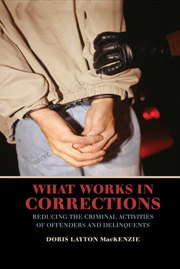Book contents
- Frontmatter
- Contents
- Acknowledgments
- PART ONE STRATEGIES FOR REDUCING CRIME
- 1 Strategies for Reducing Recidivism
- 2 Evidence-Based Corrections
- 3 Incapacitation
- 4 Perspectives on Rehabilitation
- PART TWO THE EFFECTIVENESS OF REHABILITATION PROGRAMS
- PART THREE TARGETING SPECIFIC TYPES OF OFFENDERS
- PART FOUR MANAGEMENT AND TREATMENT OF SUBSTANCE ABUSERS
- PART FIVE CONTROL, DISCIPLINE, AND PUNISHMENT
- PART SIX CONCLUSIONS
- References
- Index
- CAMBRIDGE STUDIES IN CRIMINOLOGY
2 - Evidence-Based Corrections
Published online by Cambridge University Press: 27 July 2009
- Frontmatter
- Contents
- Acknowledgments
- PART ONE STRATEGIES FOR REDUCING CRIME
- 1 Strategies for Reducing Recidivism
- 2 Evidence-Based Corrections
- 3 Incapacitation
- 4 Perspectives on Rehabilitation
- PART TWO THE EFFECTIVENESS OF REHABILITATION PROGRAMS
- PART THREE TARGETING SPECIFIC TYPES OF OFFENDERS
- PART FOUR MANAGEMENT AND TREATMENT OF SUBSTANCE ABUSERS
- PART FIVE CONTROL, DISCIPLINE, AND PUNISHMENT
- PART SIX CONCLUSIONS
- References
- Index
- CAMBRIDGE STUDIES IN CRIMINOLOGY
Summary
SCIENTIFIC EVIDENCE FOR WHAT WORKS
Strategies for reducing crime should be based on scientific evidence. By the term “evidence-based corrections,” I refer to the need to use scientific evidence to make informed decisions about correctional policy (MacKenzie, 2002; MacKenzie, 2001; MacKenzie, 2000; MacKenzie 2005). That is the subject of this book.
In this book, I use four different approaches to evaluate the research and assess the effectiveness of crime reduction strategies: (1) reviews of the research literature, (2) meta-analyses used to examine groups of studies, (3) simulation studies, and (4) a scientific methods scoring system that uses the direction and significance of studies. There are several reasons for using different methodologies to review and assess the research and to draw conclusions about effectiveness in crime prevention. First, some strategies of crime prevention do not lend themselves to program evaluation that can be easily categorized using the scientific methods score designed to assess the quality of the science. Second, by using different methods to assess effectiveness, it is possible to discern agreement among the different methods.
LITERATURE REVIEWS
Reviews of the research literature have traditionally been used to determine whether there is evidence that some particular program, strategy, or intervention is effective in producing the intended outcome (e.g., reduce recidivism). The reviewer, usually someone who is knowledgeable about the topic area, examines the studies and draws conclusions about the findings based on the direction and significance of the results.
- Type
- Chapter
- Information
- What Works in CorrectionsReducing the Criminal Activities of Offenders and Deliquents, pp. 20 - 32Publisher: Cambridge University PressPrint publication year: 2006



